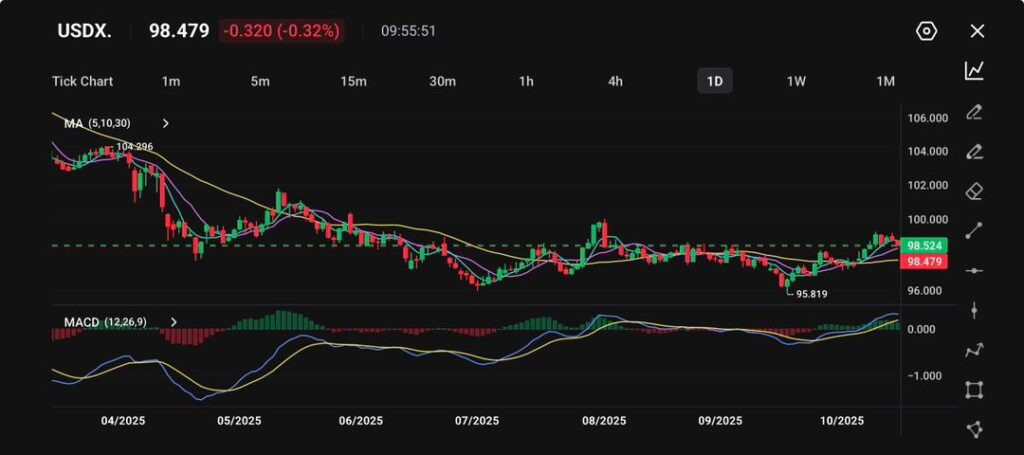The US dollar weakened to its lowest level in nearly a week on Wednesday, sliding to around 98.77 against a basket of major currencies. The decline followed dovish remarks from Federal Reserve Chair Jerome Powell and renewed tensions between Washington and Beijing.
Speaking at a conference in Philadelphia, Powell warned that the US labour market faces ‘significant downside risks’, a comment widely read by traders as a signal that the Fed could be preparing to deliver another rate cut at its upcoming policy meeting on 29 October.
Analysts at our research desk noted that Powell’s tone was consistent with the recent soft patch in US economic data, which has strengthened expectations of a near-term adjustment in monetary policy.
Futures markets now suggest a strong likelihood of a 25-basis-point cut, extending the dollar’s recent decline.
Trade Tensions Back In Focus
The greenback came under further strain after President Donald Trump threatened to sever certain trade links with China, including exports tied to cooking oil, in retaliation for Beijing’s continued reluctance to purchase US soybeans.
The remarks reignited concerns over the fragility of trade relations between the world’s two largest economies, unsettling investors who had hoped for signs of stabilisation.
A mix of dovish policy expectations and renewed trade uncertainty prompted traders to pare back their dollar exposure. The euro and yen gained ground, while gold edged higher as safe-haven demand returned.
Technical Analysis
The US Dollar Index (USDX) was last seen trading around 98.48, down 0.32% on the day, as markets reassessed the Fed’s interest rate outlook following weaker readings in inflation and retail sales.
The pullback suggests mild profit-taking after the index’s recent rebound from the 95.80 support region, while market sentiment shifts cautiously ahead of upcoming Fed speeches and macro data releases.
From a technical standpoint, the dollar index remains in a fragile recovery phase. After bottoming near 95.82 in late September, the USDX climbed steadily but has yet to reclaim its 100.00 resistance zone.

The latest rejection near 99.00–99.20 signals a potential short-term pause in momentum. The index is currently hovering around the 30-day moving average, while the 5- and 10-day MAs are showing signs of convergence, a possible indicator of consolidation.
The MACD reflects waning bullish momentum, with the histogram narrowing and the signal line flattening. A crossover below the MACD line would confirm a renewed bearish shift.
Immediate support lies at 97.80, followed by 96.50, while resistance remains capped at 99.50–100.00.
On the fundamental front, easing US CPI figures have tempered expectations for further Fed tightening, while geopolitical jitters and uneven global growth are keeping safe-haven demand for the dollar in check. Meanwhile, stronger performances from European and Asian currencies have contributed to mild downside pressure on the greenback.
Outlook
The near-term outlook for the dollar appears mildly bearish as markets brace for potential policy easing and keep a close watch on US-China trade developments.
While short-term volatility is likely to persist, sentiment has begun to tilt modestly in favour of risk assets and non-dollar currencies.
Create your live VT Markets account and start trading today.







